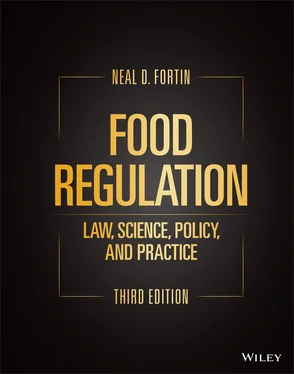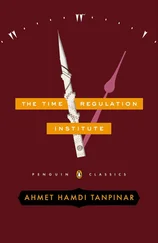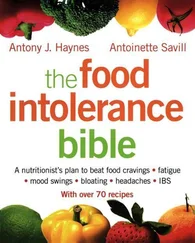Neal D. Fortin - Food Regulation
Здесь есть возможность читать онлайн «Neal D. Fortin - Food Regulation» — ознакомительный отрывок электронной книги совершенно бесплатно, а после прочтения отрывка купить полную версию. В некоторых случаях можно слушать аудио, скачать через торрент в формате fb2 и присутствует краткое содержание. Жанр: unrecognised, на английском языке. Описание произведения, (предисловие) а так же отзывы посетителей доступны на портале библиотеки ЛибКат.
- Название:Food Regulation
- Автор:
- Жанр:
- Год:неизвестен
- ISBN:нет данных
- Рейтинг книги:4 / 5. Голосов: 1
-
Избранное:Добавить в избранное
- Отзывы:
-
Ваша оценка:
- 80
- 1
- 2
- 3
- 4
- 5
Food Regulation: краткое содержание, описание и аннотация
Предлагаем к чтению аннотацию, описание, краткое содержание или предисловие (зависит от того, что написал сам автор книги «Food Regulation»). Если вы не нашли необходимую информацию о книге — напишите в комментариях, мы постараемся отыскать её.
Food Regulation: Law, Science, Policy, and Practice
Food Regulation: Law, Science, Policy, and Practice, Third Edition,
Food Regulation — читать онлайн ознакомительный отрывок
Ниже представлен текст книги, разбитый по страницам. Система сохранения места последней прочитанной страницы, позволяет с удобством читать онлайн бесплатно книгу «Food Regulation», без необходимости каждый раз заново искать на чём Вы остановились. Поставьте закладку, и сможете в любой момент перейти на страницу, на которой закончили чтение.
Интервал:
Закладка:
Other products, however, might not present such clear distinctions. This subject is discussed in more depth in future chapters, but it is important to understand that the intended use of a product may determine whether it is a conventional food, a dietary supplement, or a drug. A generation ago, any health claim for a food or supplement moved the regulation of the product to “drug” status. Food–drug distinctions are less clear today because health claims no longer automatically move a food or dietary supplement over to regulation as a drug. FDA‐approved health claims are permitted, for instance, without triggering drug status. In addition, structure–function claims are a category of health‐related claims that are not regulated as health claims (for example, “calcium helps build strong bones”).
Foods can make structure–function claims without automatically being regulated as drugs. On the other hand, non‐food products that bear a structure–function claim fall into the drug category. 9 This is why the food/non‐food determination is pivotal when examining structure–function claims on products.
The law is straightforward on simple claims. This organization becomes murky at times because it can be difficult to draw distinctions between structure–function claims that may imply a drug claim. Chapter 5returns to this topic in detail. For now, just be sure to understand two straightforward ways a product may be regulated as a drug, subparagraphs (B) and (C), in the drug definition:
Non‐food that is intended to affect the structure or any function of the body.
Intended use in the diagnosis, cure, mitigation, treatment, or prevention of disease in man or other animals.
2.3.1 Products Ordinarily Considered Foods
A claim indicating an intended use in the diagnosis, cure, mitigation, treatment, or prevention of disease is a drug claim. There have been a number of cases where products—ordinarily considered foods—were classified as drugs because of the product’s therapeutic claims:
Honey 10
Vinegar and honey 11
Tea 12
Water 13
Blue‐green algae 14
Mussels 15
2.3.2 Evidence of Intended Use
In determining whether a product is a “drug” because of intended use, the FDA is not bound by a manufacturer’s subjective claims of intent. 16 Actual therapeutic intent may be found on the basis of any objective evidence. Such evidence may be inferred from “labeling, promotional material, advertising, and any other relevant source .” 17
Unlike the definition of “drug,” the FD&C Act definition of “food” lacks any reference to intent. Nonetheless, a court may consider the intended use of the product in considering whether it is a food. However, a manufacturer’s subjective intent that a product should not be consumed will not allow the product to avoid the reach of the FD&C Act if the product looks like food and smells like food.
2.4 OTHER CONSIDERATIONS
2.4.1 Products Intended to Be Processed into Food
A number of articles have been deemed to be “food” within the meaning of the FD&C Act definition because they are intended to be processed into a food or a component of food.
Green coffee beans—It makes no difference if the beans require further roasting and processing before they would be ready for consumption. 18
Live beef cattle—The edible tissues of live calves constitute “food” as defined by the FD&C Act and are therefore subject to the adulteration provisions of the act. 19
2.4.2 Products No Longer Fit for Food
A product that is generally regarded as a food is considered a food under the FD&C Act, even if the product is decomposed or otherwise unfit for consumption. For example, a shipment of incubator reject shell eggs was still “food” although a large percentage of them were inedible. 20 The product might not be intended to be eaten, but if there is a danger of the product being diverted to food use, the product is considered a food. Note that the intended use of the product is irrelevant to this determination, which is based on the product being in the form of a food.
2.4.3 Packaging Materials
The definition of “food” is significantly broadened by the inclusion of food additives within the definition of food. Food additives include any substance whose intended use results or may reasonably result in its becoming a component or otherwise affecting the characteristics of any food . 21 Thus, the definition of food includes any substances that migrate to the food from the packaging materials or containers. 22
DISCUSSION QUESTIONS
1 2.2 Bottled water. Within the meaning of the FD&C Act, could bottled water be characterized as a food, a drug, or both? How? Would your answer change if the product were cherry juice concentrate?
2 2.3 Blackboard chalk. When would blackboard chalk be a drug?
3 2.4 “SkyHigh” brand glue is not only efficacious as glue, but is widely known to induce a high when sniffed. The manufacturer advertises the adhesive properties of the glue heavily in magazines that are popular in the drug culture. Can FDA regulate the glue?
4 2.5 Statutory drafting. Is the definition of “food” good statutory drafting?
5 2.6 Coffee is often consumed for its stimulant effect. Coffee is not con sumed for its nutritional value. If a manufacturer promoted its coffee for the stimulant effect, would it be a drug?
6 2.7 Caffeine is regulated as an over‐the‐counter drug when sold as a stimulant pill. 21 C.F.R. § 340. However, FDA does not regulate caffeine added to foods as a drug—even when the food is promoted as a stimulant. How do you reconcile the agency’s decision? Is this exception within the scope of the structure/function exception for foods within FD&CA § 201(g)(1)(C)?
7 2.8 Putrid and decomposed food that is clearly inedible would not be called “food” in everyday speech. What would be the regulatory consequence if putrid and decomposed food were excluded from the definition of food?
8 2.9 Vitamins and minerals without therapeutic claims have generally been classified as foods. However, in the 1970s, reports of human toxicity emerged from consumption of large doses of the vitamins A and D. These fat‐soluble vitamins create special concern because they can accumulate in the fatty tissue. To deal with this problem, in 1972 and 1973, FDA promulgated regulations classifying certain high dosages of vitamin A and D as drugs and requiring that they be sold by prescription. 37 Fed. Reg. 26618 (Dec 14, 1972) and 38 Fed. Reg. 20723 (Aug 2, 1973). However, in National Nutritional Foods Ass’n v. Mathews, 557 F.2d 325 (2d Cir. 1977), the court questioned FDA’s approach and found FDA’s administrative record incomplete. In particular, the court questioned whether FDA could classify vitamins as drugs when no intended therapeutic use was offered by the vendors, the labeling, or any promotional material. The court upheld the regulations, but FDA nonetheless later rescinded them. 43 Fed. Reg. 10551 (Mar 14, 1978).
Notes
1 1 21 U.S.C. Sec. 321 et seq.
2 2 Statutory citations used in this material generally are to the FD&C Act statutory sections. The citation within the brackets is the U.S.C. number. The United States Code (U.S.C.) is organized into subject matter titles with numbering that is unique from the section numbering in the statutes. For example, section 201 of the Food, Drug, and Cosmetic Act is codified as 21 U.S.C. § 321. Thus, this section is cited as “FD&C Act Sec. 201 [321].”
3 3 See 21 U.S.C. § 321(s).
4 4 21 U.S.C. § 392(b).
5 5 See, e.g., 21 U.S.C. § 644 (regarding transporting in commerce dead, dying, disabled, or diseased animals).
Читать дальшеИнтервал:
Закладка:
Похожие книги на «Food Regulation»
Представляем Вашему вниманию похожие книги на «Food Regulation» списком для выбора. Мы отобрали схожую по названию и смыслу литературу в надежде предоставить читателям больше вариантов отыскать новые, интересные, ещё непрочитанные произведения.
Обсуждение, отзывы о книге «Food Regulation» и просто собственные мнения читателей. Оставьте ваши комментарии, напишите, что Вы думаете о произведении, его смысле или главных героях. Укажите что конкретно понравилось, а что нет, и почему Вы так считаете.












